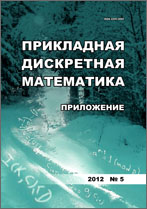|
Mathematical Methods of Cryptography
Applications of two-faced processes to pseudorandom number generation
B. Ya. Ryabko
Institute of Computational Technologies, Siberian Branch of the Russian Academy of Sciences, Novosibirsk
Abstract:
Random and pseudorandom number generators (RNG and PRNG) are used for many purposes including cryptographic applications. For such applications, a generated bit sequence should mimic true random, i.e., by definition, such a sequence could be interpreted as the result of the flips of a “fair” coin with sides that are labelled 0 and 1. It is known that the Shannon entropy of this process is 1 per letter, whereas for any other stationary process with binary alphabet the Shannon entropy is strictly less than 1. On the other hand, the entropy of the PRNG output should be much less than 1 bit (per letter), but the output sequence should look like truly random. We describe random processes, for which those, in a first glance contradictory, properties are valid. More precisely, it is shown that there exist binary-alphabet random processes whose entropy is less than 1 bit (per letter), but a frequency of occurrences of any word $u$ goes to $2^{-|u|}$, where $|u|$ is the length of $u$. In turn, it gives a possibility to construct RNG and PRNG, which possess theoretical guarantees. This is important for applications of them in cryptography.
Keywords:
random number generator, pseudorandom number generator, Shannon entropy.
Citation:
B. Ya. Ryabko, “Applications of two-faced processes to pseudorandom number generation”, Prikl. Diskr. Mat. Suppl., 2016, no. 9, 68–70
Linking options:
https://www.mathnet.ru/eng/pdma294 https://www.mathnet.ru/eng/pdma/y2016/i9/p68
|

|




 Contact us:
Contact us: Terms of Use
Terms of Use
 Registration to the website
Registration to the website Logotypes
Logotypes








 Citation in format
Citation in format 